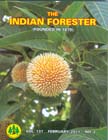Effect of Temperature and Relative Humidity on the Development of Sal Defoliator, Ascotis imparata Walk. (Lepidoptera: Geometridae)
DOI:
https://doi.org/10.36808/if/2011/v137i2/12092Keywords:
Ascotis Imparata, Development, Temperature, Relative Humidity, Survival PercentageAbstract
Temperature and humidity are the two main factors that influence the rate of survival and development of sal defoliator, Ascotis imparata Walk. (Lepidoptera: Geometridae), which is an economically important polyphagous pest of sal and other plants in plantations and natural forest. Study of effect of temperature and humidity revealed that the best suited temperature was 25°C to 30°C with 70 to 75% relative humidity. Low temperature (10-15°C) and high humidity (80-90%) and vice - versa was found unfavourable for development and survival of the larvae of A. imparata. The o maximum survival percentage (96 per cent) of larvae was observed at the temperature 25 C with 75% o relative humidity while minimum (16%) survival was at 40°C with 60%. The optimum condition to complete the pupal development was 30°C temperature with 70% relative humidity. At this condition pupae completed development at minimum period of 14.06 days with maximum survival of 91.30 per cent.Downloads
Download data is not yet available.
Downloads
Published
2011-02-01
How to Cite
Singh, K. P. (2011). Effect of Temperature and Relative Humidity on the Development of Sal Defoliator, <I>Ascotis imparata</I> Walk. (Lepidoptera: Geometridae). Indian Forester, 137(2), 221–224. https://doi.org/10.36808/if/2011/v137i2/12092
Issue
Section
Articles
License
Unless otherwise stated, copyright or similar rights in all materials presented on the site, including graphical images, are owned by Indian Forester.





